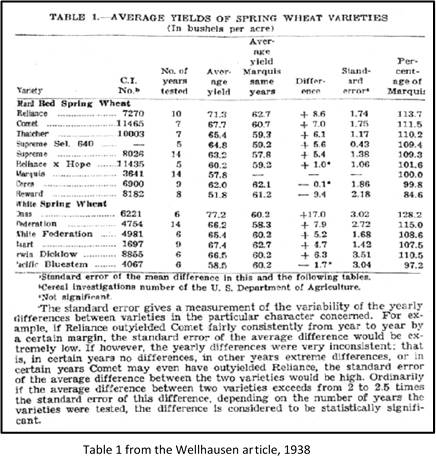Agriculture and Statistics in the 1930s
by Dick Lund
Agriculture researchers in England and the U.S. were actively advancing statistical thinking during the 1920s. Were the MSC agricultural faculty and students aware of the two statistics courses available in the math department? Did they realize that these new ideas offered objective ways to evaluate the validity of their research conclusions? Attempting to supply an easy answer, I (Dick Lund) “thumbed quickly” through all Montana Agriculture Experiment Station (MAES) Bulletins for the decade of the 1930s, numbers 232 to 383, about two linear feet of space on the library shelf. I looked for instances of authors acknowledging and reporting random variation in their research data, and hopefully, evaluating the validity of their conclusions by some form of probability statements.
I found only two suitable bulletins. The first was Bulletin 234, October 1930, by LeRoy Powers, an assistant agronomist at MAES. He published “average” wheat yields for several varieties from experiments conducted during 1922-28 and showed his results for example as 56.5 ± 1.34 bu. acre. The statement was accompanied by neither the basis for the “± 1.34" nor information on the size and number of experimental plots used. In looking at the LeRoy Powers paper, I wonder if he was using normal-based quartile estimates that produce the "probable error."
The second was Bulletin 365 , December 1938, by E. J. Wellhausen, agronomist at MAES. It presented “average” wheat
yields for fifteen varieties from experiments conducted during several previous years.
His Table 1 clearly used comparisons to a control (Marquis variety). Wellhausen also
described his experimental methods, size of plots and replication. It would have been
gratifying if he had recognized Tallman or Tallman’s courses, however, it is likely
that he arrived at MSC with statistical knowledge acquired at Iowa State University
(ISU) where he had completed his doctoral degree two years earlier. The statistics program at ISU and its influence on agriculture science was widely
recognized at that time, as was ISU’s Statistical Laboratory.3
, December 1938, by E. J. Wellhausen, agronomist at MAES. It presented “average” wheat
yields for fifteen varieties from experiments conducted during several previous years.
His Table 1 clearly used comparisons to a control (Marquis variety). Wellhausen also
described his experimental methods, size of plots and replication. It would have been
gratifying if he had recognized Tallman or Tallman’s courses, however, it is likely
that he arrived at MSC with statistical knowledge acquired at Iowa State University
(ISU) where he had completed his doctoral degree two years earlier. The statistics program at ISU and its influence on agriculture science was widely
recognized at that time, as was ISU’s Statistical Laboratory.3
- Dick Lund
return to discussion in Statistics at MAES: 1981-1995
Era 4 (Statistics Program at MSC)
Table of Contents
Last revised: 2021-04-18
